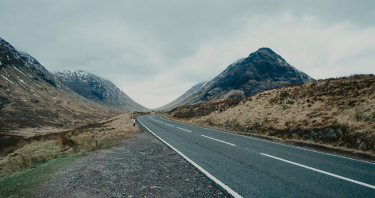When we talk about Scotland the first thing that comes to mind is Edinburgh or simply Loch Ness. And coming to Scotland means visiting both, its two most internationally famous locations. The question arises when we realize that the lake (or loch) has an extension of about 40 kilometers that make us doubt which is the best place to stop and see it. Fort Augustus is the closest option for trying to see the Loch Ness monster and of course enjoying the landscapes of the Highlands. Here we offer you a guide to Fort Augustus to enjoy the town. If you want us to accompany you, we offer you a Tour from Edinburgh to Loch Ness, in which apart from knowing something, you can enjoy the history that has made Scotland a unique country.
Fort Augustus
Thousands of years have passed since the first settlers saw this place as an optimal place to settle. Cherry Island is the only island in the entire lake. It is the best example of this primitive settlement, known as Crannog, they are artificial islands near the shore of the lakes.
Fort Augustus is a town of about 700 inhabitants located in the heart of the Scottish Highlands. Kiliwhimin was its old name in Gaelic, until in the 18th century when it received the current name. The reason for this change was the Jacobite Wars and the construction of a fort for the control of the Scottish rebels in the north.
The military fort was installed on this obligatory passage to Inverness, “the capital of the Highlands”. Centuries later, the fort was replaced by an abbey of Benedictine monks, whose building is by its appearance the most striking and monumental.
But, Fort Augustus is, due to its privileged location, the place that promises us the exclusive panoramic view of Loch Ness. An exclusive viewpoint that in recent years has seen its importance grow thanks to tourism.

Picture: Visit Scotland / Autor: Kenny Lam
What to see and what to do
Loch Ness
The famous lake (loch), thanks to the “monster” is also famous for its monstrous dimensions; 39 kilometers long and 230 meters deep, making this lake the largest volume of water in the UK.
This vast amount of water has been the focus of attention since the origins of the settlement on its banks, which saw in its waters a way of life that provided them with food and easy transportation. Currently, it is one of the highlights of tourism in Scotland, which energizes this part of the country.
Loch Ness has always been a strategic junction between the north and center of the Highlands. Its exit to the North Sea, through the River Ness, and the confluence of great valleys have caused numerous wars for its control. Picts and Romans, Celts and Vikings, Scots and English are some of the peoples who have fought on its shores.
In any case, it is because Loch Ness appears in all the lists of mysterious places thanks to Nessie. It is also included in the lists of places to visit at least once in a lifetime. If you are visiting Scotland, a trip to Fort Augustus and seeing the south side of Loch Ness, it should be a must.
Loch Ness Cruises
For those who are not satisfied with the shore and want to explore the lake, the option is a cruise. Have the possibility to explore the loch and check the impressive landscape that surround it. The cruise ship has radars and motion sensors to record any Nessie signal.
The mystery has also been attached to it, Saint Columba of Iona was called by a Pictic tribe to appease a monster that inhabited the lake in the 6th century. Later, newspaper articles spoke of the mysterious creature. All until the famous photo of Nessi arrived, swimming placidly in the lake. Today, it continues to speak. Almost every year new theories arise and even photographs and videos that indicate their existence.
The cruise lasts one hour and there is a discount for clients of LochNessBus.com on our Loch Ness and Highlands Tour. We recommend you take advantage of the cruise for lunch, buying something to take in any of the restaurants or supermarkets in town.
The Caledonian canal
This town is currently famous for being on the banks of Loch Ness, but also for the channel that runs through it and which receives the Latin name of the country that it cuts in two.
Not so long ago that winter navigation along the northern tip of the North Sea was not only difficult but dangerous. Icebergs and ice sheets, as well as storms were factors that threatened the crossings. Boats with precious cargoes, but above all human lives were at stake.
So dire were the conditions of navigation along the Scottish west coast that they pushed the construction of a canal taking advantage of the great valley where Loch Ness sits. Almost 100 kilometers that serve to unite the Atlantic Ocean with the North Sea.
The canal takes advantage of large lakes such as Ness to save construction time, money and effort. However, the main problemis the enevenness along all the way. The most practical solution is the canal lock. In the small town of Fort Augustus sits one of the stairways, which we can hopefully see in operation on our visit. Around them there is a walk that follows the edges of the canal and we really recommend to walk.

Picture: Visit Scotland / Autor: Kenny Lam
Caledonian Canal Centre – Fort Augustus
To learn about the influence of the Caledonian canal in the Scottish Highlands and discover how one of the most important civil engineering buildings of the time was forged, it is essential to visit the interpretation center.
The exhibition includes plans, photographs and explanations about the work. We will also find out about Thomas Telford, the Scottish engineer who was able to convince the world that it was possible to change the course of nature.
Interestingly, the effective use of the channel was quite poor. When it was completed, the merchandise ships it had been designed for had increased in size. The channel had become too small before operating at full capacity. A new life came to him from the 1960s, when the British began to use pleasure boats to tour Scotland from the North-East to the South-West. Currently still in use.
Admission is free and its hours are from Sunday to Saturday – 9:00 to 18:00.
Benedictine abbey
In 1874, the third Marquess of Bute attempted the recovery of the monasteries in Scotland. After the Protestant Reformation and the religious and dynastic wars, the monasteries had been disappearing. The 13 lord of Lovat gave up the land of the old fortress of 1729, destroyed during the Jacobite wars, for the construction of a monastery under the tutelage of the Benedictines at Fort Augustus. In 1880 the monastery and a college for the upper classes in the area were completed. Both depended directly on the Catholic hierarchy of England, until it became dependent on the Holy See in the late 19th century. The school was a prestigious and financial engine until 1993, when it was closed as it did not adapt to changes in the Scottish educational system.
Today it is a Club with a hotel, restaurant and conference rooms.
Views
The striking town stands out for its views, we highlight three main points:
- The top of the lock staircase. A magnificent view over the buildings and the loch with the valley in the background.
- The revolving bridge. You can spot the end of the channel and the lake as main views.
- From both ends of the channel. The Loch Ness rules the entire view.
Where to eat
Restaurants and pubs
The Moorings: The restaurant with the most competitively prices in the whole town, which stands out for its takeaway dishes. It has an outdoor terrace and because it is next to the canal, it is usually the place chosen for those who want a quick service and enjoy a cruise on the lake. Among the takeaways it offers pizza, kebabs, hamburgers and, of course, fish and chips.
Address: Canal Side, Fort Augustus
Lock inn, In a homely atmosphere and with direct views over the Caledonio canal locks, it offers fresh food at affordable prices. They boast of cooking with local products and their simple dishes, typical of pubs. In summer it enables a dining room on the first floor with views of the Caledonio Canal and allows us to enjoy the rise and fall of ships through the locks.
Address: Canal Side, Fort Augustus
Bothy restaurant It’s a good place to enjoy a typical Scottish menu where you can not miss the venison and the Haggis. In the bar of the same name you cannot miss a good collection of whiskeys “Single Malt” and local beers. The building is an old farm from 1800 and has a large restaurant area, apart from the bar area.
Address: Canal Side, Fort Augustus
Boathouse, The best location is reserved for this restaurant, located on the old pier of the abbey. A perfect place to enjoy your food while you contemplate the best direct views of the lake. It is, without a doubt, the most reputable restaurant in Fort Augustus and belongs to The Higland Club. Among its dishes, we can find some tribute to the popular monster of the Loch Ness.
Address: The Highland Club, St.Benedict’s Abbey, Fort Augustus
Supermarkets
Mac Evans It is located on the banks of the canal. Apart from the supermarket area, it usually offers takeaways and has a restaurant overlooking the Oich river.
Address: Canal Side, Fort Augustus
D J Macdougall Butcher It is a traditional butcher shop founded in 1884. It offers lamb, venison, fallow deer and pork, and its specialties include Haggis and Black Pudding. Their homemade sausages, meat pies, hamburgers are in high demand. It also has fruit and vegetables.
Address: Canal Side, Fort Augustus
Gift shops
Clansman centre, a small center for interpreting the history of the Highlands and its people, focusing on the uses and customs of the 17th century. There are also items on sale for traditional Highland products, from Celtic or Pictic jewelry to a tribute to Nessie.
Clansman Center / Address: Canal Side, Fort Augustus
The Mill Shopresides in the space of the old village church. It offers typical products from Scotland: wool clothes, butter cookies, jewelry and kilts for all ages and sizes. It also has cashmere garments and traditional wool clothing from the island of Aran.
Address: Canal Side, Fort Augustus


















